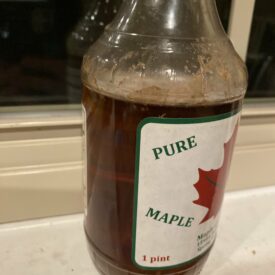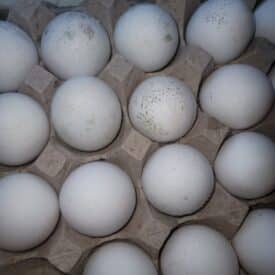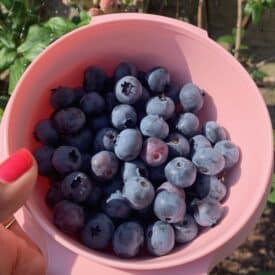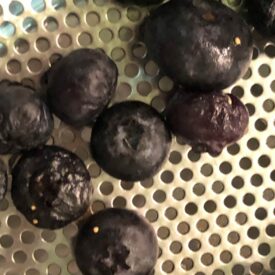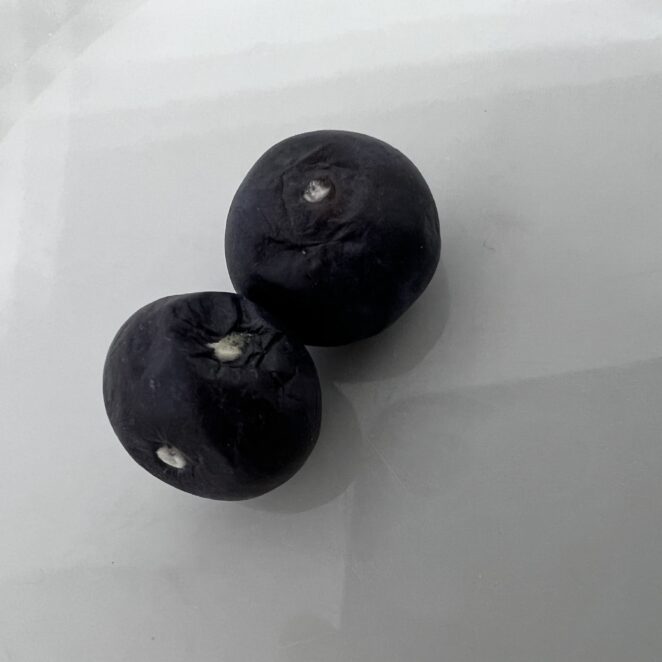
What you see: Cottony white spots on your blueberries; probably where the stem attached or where there might have been a wound in the blueberry’s skin.
What it is: Mold. Most likely Botrytis cinerea, also known as gray mold. Winemakers call it Noble Rot or, less flatteringly, Ignoble Rot, depending on how it’s behaving.
Eat or toss: Don’t eat the moldy berry, but unaffected neighboring berries are probably fine.
White, cottony spots where blueberry stems used to attach are probably mold
For a mold that’s looking to feast, any tiny breaks in a fruit’s skin are like wide open doors. In a blueberry, a cut, bruise or weakness in the spot where the stem used to attach can give a microbe access to the sweet, wet fruit flesh.
A fungus known as gray mold (Botrytis cinerea) often arrives, unannounced and uninvited, at those welcoming thresholds that we larger blueberry eaters might not even be able to see. While we can’t say for absolute certain that Botrytis cinerea is the perpetrator in the image above, Mark Longstroth, a retired small fruit educator at Michigan State University told me it’s quite likely. Botrytis cinerea is a common mold that fuzzes up anything from blueberries to tomatoes to lettuce.
Look closely at the image and you’ll see that the mold settled into the spots where the stems connected in both berries. The berry on the left also had some kind of an injury, into which a mold spore landed, germinated and sprouted nutrient-absorbing white threads called hyphae.
Even if you don’t see an open wound, a bruise can weaken a fruit’s skin enough that a spore can sneak in. Plus, as produce ages, its cells become less resistant to infection. Older berries are more vulnerable.
The blueberry mold could have come from my fridge or kitchen; mold spores are an invisible and ubiquitous part of our environment. Or, as Longstroth said was more likely, gray mold spores could have been happily sitting on the berries since way back when on the blueberry bush, or at least since they were picked, when mechanical harvesting and sorting would have caused lots of berries to cross paths and, potentially, trade spores. Back then, however, the blueberry could have looked pristine and the mold could have been nothing more than a spore invisible to the naked eye. It’s common for molds to stay in a latent stage until the fruit they’re sitting on is softer and easier to invade.
Blueberries with mold aren’t good to eat
While allergy or asthma sufferers might be bothered by inhaling airborne spores of this mold, it’s not known to produce toxins that can harm people if eaten (while molds common in home kitchens rarely cause acute issues, you should always be wary because some toxin-producing molds do grow on food). In fact, grapes are deliberately infected with Botrytis cinerea to help concentrate their sugars and flavors for dessert wines. In that scenario, the mold is known as noble rot. However, if growers don’t manage it properly, it can destroy the grapes, leading to the less pleasant “ignoble rot.”
So, the mold we’re talking about in this post, which manages to show up on any blueberries that I don’t eat quickly enough (sometimes it takes days, other times weeks), is most likely the relatively harmless Botrytis cinerea. If you accidentally eat one, you probably don’t have much to worry about, but we’d advise against eating more. That’s for a couple reasons:
- First, you can’t be certain that this definitely is Botrytis cinerea. Just as you wouldn’t eat an unidentified mushroom in the forest, you don’t want to eat an unidentified mold. Many molds won’t make you immediately sick if you eat them, but still contain toxins you don’t want to consume.
- Second, the mold will be busy breaking down the berry and belching out various substances, which means the berry probably won’t taste so good.
The best way to avoid finding Botrytis cinerea fluff on your blueberries is to eat them soon after purchase, especially if you’re buying them out of season and the berries have traveled from another hemisphere–those fruits are more likely to be older and thus more vulnerable to decay.
SOURCES:
- Mark Longstroth. Retired Small Fruit Educator. Michigan State University Extension.
- GRAY MOLD (BOTRYTIS BLIGHT). Original Authors: Nancy Doubrava, Former HGIC Horticulture Information Specialist; James H. Blake, EdD, Extension Associate/Adjunct Professor, Dept. of Plant and Environmental Sciences; Revisions by: Joey Williamson, PhD,
- HGIC Horticulture Extension Agent, Clemson University. Originally published 05/99.
- Botrytis blight and fruit rot Botrytis cinerea (fungus). Michigan State University.
- Revised: Jul 23, 2021. Clemson Cooperative Extension Home & Garden Information Center.

